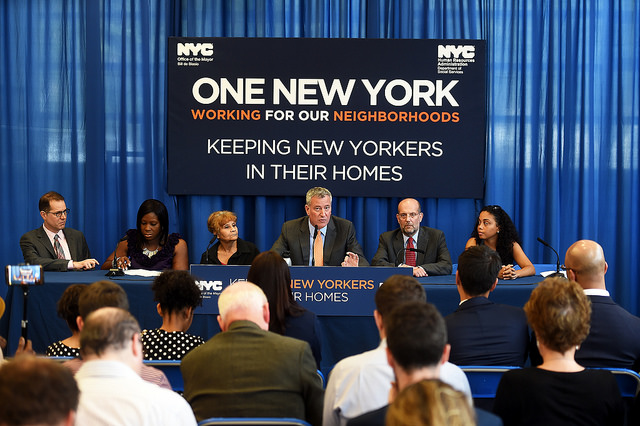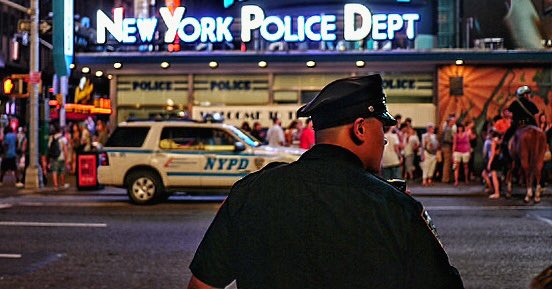Funding Lawyers is Good, Fixing Housing Policy Would Be Better

"Keeping New Yorkers In Their Homes" (photo: Demetrius Freeman/Mayor's Office)
I’m a tenant lawyer: I work for a nonprofit that receives funding from the City to defend low income people in their eviction proceedings and keep them in their homes. I can do a lot for tenants and I know Right to Counsel for indigent folks facing eviction is good policy, everyone should have a lawyer in housing court. While I can help people facing unlawful eviction, I cannot make housing more affordable in New York City. But the real reason most people face evictions in housing court is not just because they cannot afford housing -- it is a policy called vacancy decontrol.
Housing has been a challenge in New York City for more than a century, but we actually have had some form of rent regulation meant to mitigate that problem for nearly the same amount of time. It has appeared in different forms and shapes. Currently we have around one million apartments under rent stabilization. It has kept people with a roof over their head for nearly 50 years.
But rent stabilization is much less effective now than when it started. From 1974 until 1993, most rent stabilized apartments were more or less guaranteed to remain that way because of automatic lease renewals. But in 1993, the law changed and gave landlords a way to get an individual apartment out of rent stabilization once it became vacant. Vacancy decontrol became law with the support of Democrats and Republicans in the State Senate (many of whom are still around today). The law became much worse in 1997, again with wide bipartisan support. And now, the more neighborhoods gentrify, the more landlords get very hungry to push their tenants out.
Imagine what our city would look like today if vacancy decontrol had not come into effect? I am experienced enough to know that most of my clients facing eviction would be better off if vacancy decontrol was not driving their landlords toward eviction. Half my clients face evictions with dubious claims, and everybody in court - the lawyers, the judges, and certainly the tenants, know that beneath the legal pretext, the real desire to evict them is to get the apartment up to market rate rent. The other half of my clients face nonpayment cases in increasingly expensive apartments with no option of more affordable housing to find, because more and more of their neighborhood apartments have been decontrolled.
To be sure, a tenant with a lawyer will discourage some landlords from weak claims due to the potential cost of a lengthy trial. But money incentive to get that apartment to market rate is very high -- an extra $10,000 to $20,000 to evict a stabilized tenant in a complicated trial might be worth the hundreds of thousands a landlord can make in the long run.
While I’m happy to engage a hard fight in a case to keep people in their home, I will not win every time. And more importantly, the Right to Counsel bill before the New York City Council only covers people under 200% of the federal poverty level. There are a lot of people who will never be able to afford a quality housing lawyer but do not fit into the bill’s criteria, which would provide publicly funded attorneys to any qualifying tenant facing eviction. Unless the state Legislature changes the rent laws, we are never getting that affordable apartment back -- this discussion cannot ignore the vacancy decontrol elephant in the room.
And that is the important point - we could hire 50,000 more lawyers, but we could also just eliminate vacancy decontrol and fix housing policy in New York City. Taking that step, or any step in that direction, would secure housing for thousands and thousands of New Yorkers. We can fix the rent laws, and if we did that we might not need so many lawyers.
***
Richard Semegram is a practicing tenant lawyer. On Twitter @richagram.
***
Have an op-ed idea or submission for Gotham Gazette? Email This email address is being protected from spambots. You need JavaScript enabled to view it.
Raising the Bar for New York Real Estate

Hunter's Point South Living (image)
From iconic architecture to imposing size, there is no denying that real estate has defined New York for generations. But even the most forward-thinking developers of 50 to 100 years ago might not recognize the dizzying pace, shifting policies, and growing demands that dominate today’s industry.
Here is the hard truth facing developers these days: achieving excellence in one area does not always lead to success. In fact, it rarely does. It is no longer enough to just design a beautiful building, imagine a new public space, or revitalize an older structure. We are so often urged — and just as often expected — to accomplish all those things, or others, in a single project.
The Urban Land Institute’s mission to provide leadership in the responsible use of land and in creating and sustaining thriving communities worldwide should remind us that these development challenges are not just results of market or zoning pressures. Meeting these challenges is just as much about thoughtful planning and building a dialogue with the neighborhood leaders and planning officials who play roles in advancing new development. Perhaps most importantly – as ULI has made clear – it is about providing added value through new transit access, sustainable design, environmental resilience, or other aspects. In its simplest form, it is smart city building.
For years, ULI has helped set the bar for responsible land use with its Global Awards for Excellence, which crowns winners in cities worldwide. But the changing face of New York real estate has made it clear that we also need a local competition — one focused solely on raising the industry bar across our state.
That is why we at ULI New York launched our own Awards for Excellence in Development — a statewide contest open to private, public and non-profit developers, whether or not they are ULI members. More than anywhere else, it is vital for New York’s real estate industry to meet and even surpass the responsible land use principles laid out by ULI and our members worldwide. By recognizing and elevating leaders who take a truly holistic approach, we believe we can help increase the quality of development across the state for generations to come.
At our inaugural awards gala this past March, the first class of winners showed just how far our industry can go to meet diverse needs in New York City and upstate.
In Queens, Hunter’s Point South Living created a mixed-use, affordable housing development that established a benchmark for a new workforce housing experience. In East Harlem, the Center for Living and Learning seamlessly combined affordable apartments, a charter school, and non-profit office space to create a true community hub. In Buffalo, Conventus brought together clinical, educational, and research components in a center for collaborative medicine on the Buffalo Niagara Medical Campus. In Lower Manhattan, the National 9/11 Museum and Pavilion site carries with it both the power of its history and hope for the future in commemorating those who lost their lives on September 11, 2001. These were just a few of the projects that inspire us all to reach greater heights.
On September 12, ULI New York opened the nomination period for our Second Annual Awards for Excellence in Development — and we hope to see even more submissions than we did last year. With two new award categories, we are now taking project submissions in a total of eight categories: office, housing, mixed-use, repositioning or redevelopment, hotel, retail, institutional, and civic space. Developers interested in submitting a project should visit our website for details on applying. Our Awards Committee will accept submissions until November 4, after which the finalists in each category will be announced in January.
Our team is committed to finding the most outstanding developments in New York and helping our industry meet every challenge. But we can only do that if developers in every corner of the state are willing to participate and put their best new projects up for consideration. We know our next winners are out there — and we are excited to see what the future of real estate looks like.
***
Marty Burger is CEO of Silverstein Properties and Chairman of ULI New York. On Twitter @ULINewYork.
***
Have an op-ed idea or submission for Gotham Gazette? Email This email address is being protected from spambots. You need JavaScript enabled to view it.
Eleanor Bumpurs, Deborah Danner, and Finally Fixing Our Emergency Response

(photo: @NYPDnews)
Heartbreak and outrage at another deadly police shooting - this time concerning Deborah Danner, a 66-year-old woman with a psychiatric disability. Police, responding to a call about an "emotionally disturbed person," entered her apartment and when the woman became agitated and combative, an NYPD Sergeant killed her.
It is all achingly familiar. In 1984, Eleanor Bumpurs, who was also a disabled elderly black woman in the Bronx, was killed with twin shotgun blasts in similar circumstances.
In the wake of Bumpurs' death, which generated widespread outrage but no charges or discipline to the officers involved, the NYPD tightened its use of force rules and internal procedures. Since then police are only supposed to use deadly force if there is an immediate threat to someone's life.
In this case, reports indicate Danner was naked and holding a pair of scissors when police confronted her. The officer was able to get her to drop the scissors but she then allegedly threatened the officer with a wooden bat. While a bat can be a serious weapon, capable of causing real injury, this shooting could have been avoided - something both NYPD Commissioner James O’Neill and Mayor Bill de Blasio quickly said on Wednesday, the day after Danner was killed.
Officers knew that they were going to be confronting someone with schizophrenia. They had been there several times before. The sergeant who killed her had his standard issue Taser.
Why did the officer not use his Taser? The reason for issuing them was to avoid exactly this kind of tragedy. Did cops have a plan to keep things from escalating? Did they have a plan to manage the presence of a weapon? Did they have a plan for retreating if necessary to preserve life?
Commissioner O'Neill stated that this was a failed interaction. That admission is a refreshing break from past defensiveness by police leaders.
There has been a great deal of discussion about how to better train police to deal with these kinds of situations, and some new training has occurred. But the problem runs so much deeper. Former cop and now law professor Seth Stoughton has documented the ways in which the bulk of police training teaches them how to be "warriors" rather than "guardians."
They are constantly reminded that any encounter can turn deadly and that they must be ready to use force at any time. That it's "better to be judged by twelve than carried by six." This helps explain recent tragic police killings like those of 12-year-old Tamir Rice, killed in a park, and John Crawford, killed in a Walmart.
But the fact that police had to even be dispatched in the first place is a sign that something went wrong.
Health officials knew about this woman's condition. Neighbors reported that they had recently seen her taken away in a straight jacket. Why was she returned to her apartment without adequate ongoing supervision or care?
The mayor has acknowledged that there is a problem with community mental health care. A recent report by his wife, Chirlane McCray, identified many of the gaping holes in the system and outlined some plans for closing them.
Yet thousands of profoundly disabled people continue to roam the streets and subways or idle away at home with little or no support, leaving police to deal with the crises that inevitably result.
There are alternatives. A coalition of service providers, advocates and family members has spent years calling on the city to create "crisis intervention teams" made up of medical professionals who could respond to calls for help.
They are trained to deal with difficult and combative people without resorting to deadly force. They could also coordinate with a community-based case worker who would be aware of the person's condition and past interactions with authorities, allowing them to develop a plan for safely resolving the call. The Health Department has a few of these teams but they don’t normally respond to 911 calls.
The mayor said that an “ESU,” or emergency service unit, was on the way, and that officers should have waited for its arrival. While that surely would have been better, it is not the same as having a crisis intervention team as first responder to such an incident with a known mentally ill person.
Even if we civilianize much of the responses to these calls, police will still have interactions with this population. We need a change in police training and culture that goes deeper than a few hours of de-escalation preparation. The mayor was wrong when he said that current training is adequate and this was just the mistake of a single officer. Ultimately, police are the wrong people to be responding to a person experiencing a mental health crisis. Until we develop robust community-based mental health services, tragedies will continue to occur.
***
Alex S. Vitale is associate professor of sociology at Brooklyn College and author of City of Disorder: How the Quality of Life Campaign Transformed New York Politics. He is senior policy adviser to the Police Reform Organizing Project and serves on the New York State Advisory Committee to the US Civil Rights Commission. On Twitter @avitale.
***
Have an op-ed idea or submission for Gotham Gazette? Email This email address is being protected from spambots. You need JavaScript enabled to view it.




